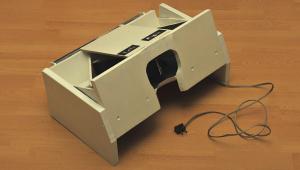Pro Talk; Frans Lanting; Life On Earth
"How do you get a handle on telling the story of life on earth in images? It took tons of research to master the material."
For his most recent book, Life: A Journey Through Time, Frans Lanting traveled,
researched, and photographed for over six years, but when you consider that
his goal was to document the story of life on earth, it seems a reasonable amount
of time.
The idea for the project came to Frans when he observed horseshoe crabs coming
out of the water to spawn. In the book's introduction he notes that this
"ancient ritual...goes back hundreds of millions of years,"
and in it he saw what he calls "the past in the present." He wondered
if it would be possible to document the story of life on earth in photographs
made today; to capture images that would "evoke nature through time."
 |
|
|
He was sometimes able to pursue the project while on other assignments, but
many of his expeditions over the six-year period were planned and financed solely
for the book. "Those ended up being some of the crucial sources for new
imagery," Frans says, "because they took us to [the necessary] out-of-the-way
places. I really had to extend myself into more extreme situations for this
project, photographing active volcanoes and corrosive hot springs. And although
I'd done underwater photography occasionally, I had to apply myself a
lot more seriously. The underwater pictures were crucial images. I wasn't
looking for colorful fish--I was interested in archaic life forms."
Frans realized from the first that sponsorships would be important to the success
of the project, but he didn't pursue them right away. With something this
complex and difficult--at one point he called his project "a story
as big as the earth itself"--he had to be sure it was a viable idea
before enlisting support. "I nurtured it for a couple of years before
starting to talk about it," he says. But when he started to enlist support,
he had a lot going for him: his photographic artistry, of course, but also his
business and organizational skills. Simply, he's proven he can deliver
the big story. "But," he says, "the idea has to stand on its
own. My name and reputation go only so far. People have to understand the idea
and be inspired by it. It has to have meaning to them."
At first, though, the scope of the concept worked against him. "How do
you get a handle on telling the story of life on earth in images?" he
says. "How do you frame and organize a narrative with images to match?
Now that it's done, it looks simple and logical, but the first couple
of years were hard in both the conceptual and the photographic exploration.
It took tons of research to master the material."
Equally daunting were logistical issues. Timing, after all, is everything. "I
hate that feeling," Frans says, "when I arrive at a location and
somebody tells me, `Yeah, you should have been here last month.'
You can't avoid that--nature doesn't always respond according
to the way it should. It was a big puzzle. Sometimes I had to return to places;
other times places were one-shot deals, simply too far and too exotic to return
to."
 |
And sometimes people, not nature, presented the problem. "For an expedition
to Kamchatka in Russia we were with a group of microbiologists," Frans
says. "We arrived on a flight from Alaska on a Saturday afternoon. We
thought we had a chartered helicopter lined up for a flight into a remote part
of Kamchatka to work at the hot springs, and essentially the Russians held us
up for two and three times the amount we'd agreed on. What do you do on
a Saturday afternoon in Petropavlovsk? There are no cash machines. Well, you
dig into the reserves. And what do you do when the guards try to hit you up
for money because your permit doesn't say you can use a tripod? I'm
a veteran at this by now, and I know you can jump up and down all you want,
but ultimately, as in this case, a good cigar can go a long way toward securing
a tripod permit."
Because of the amount of research he had to do, and the knowledge he had to
apply to the search for images, help from scientists was vital. "I had
conversations with many scientists along the way [who] became very important
consultants, guiding me to a proper understanding of this material. It's
very complex, and involves half a dozen different fields ranging from geology
to paleontology, astrobiology and microbiology to genomics."
And occasionally it involves handing over a good cigar.
Frans Lanting is a Nikon "Legends Behind the Lens" featured photographer.
The current "Legends" story and an archive of profiled photographers,
including Frans, can be found at www.nikonnet.com.
Frans' website is www.franslanting.com.
The "Life" project's educational website is www.lifethroughtime.com.
















































